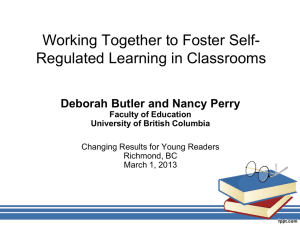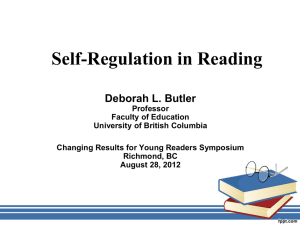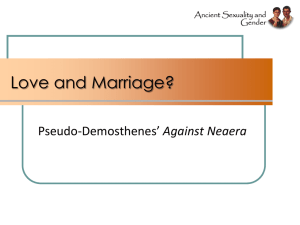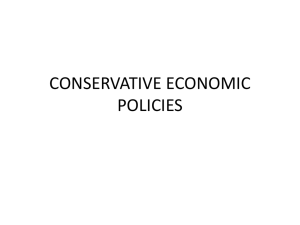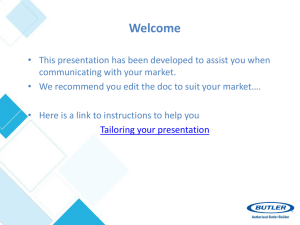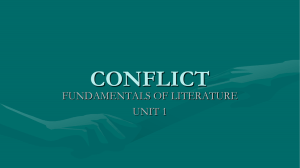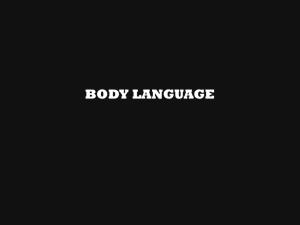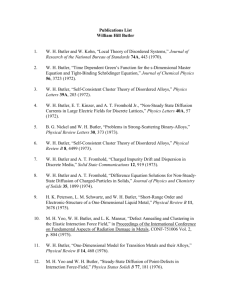Butler Power Point Presentation
advertisement
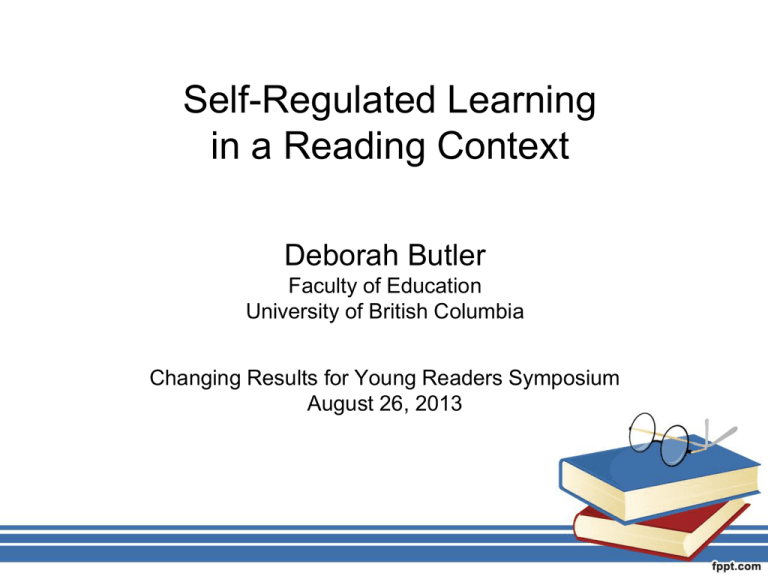
Self-Regulated Learning in a Reading Context Deborah Butler Faculty of Education University of British Columbia Changing Results for Young Readers Symposium August 26, 2013 Agenda • What is self-regulated learning in a reading context? • How can we support SRL in reading? • What questions might learning teams take up in relation to self-regulation in reading? What is self-regulation in a reading context? What is Self-Regulated Learning in a Reading Context? Classic Definition of Self-Regulation: The ability to control thoughts and actions to achieve personal goals and respond to environmental demands (Zimmerman, 2008) Self-regulation is "active," strategic engagement Learners can take, and feel in control, over activities by deliberately and reflectively “self-regulating” learning Self-Regulating Emotions and Behaviour … Successful performance involves understanding and managing one’s emotions and behaviour so as to successfully engage in activities and with others Emotions experienced; Challenges to focus or motivation Emotions & Motivation Cognition and Metacognition Awareness of expectations & one’s own strengths and challenges; one’s emotions; others’ emotions Strategic Action SelfRegulating Emotions & Behaviour Using strategies to participate effectively (e.g., avoid being distracted; focus; manage emotions; work well with others) Reflection Think of a time when you were engaged in a an activity where you experienced distracting emotions (stress, worry, excitement) or struggled with motivation What did you feel? What led you to feel that way? What did you do to stay engaged in the activity (or did you)? Promoting Emotional and Behavioural Regulation Support learners to understand their own and others’ emotions and behaviour Support learners to learn how to strategically manage their emotions, behaviour, and motivation in/through activities – Social relationships – Sport/recreation – Learning in school See http://csefel.vanderbilt.edu/ or http://www.challengingbehavior.org/do/resources/teaching_tools/ttyc_toc.htm Supporting Emotional and Behavioral Self-Regulation: Case Study Example Approach Daily conferences Building positive & trusting relationship with the student End-of-Year Observation "He is removing himself from a situation where he is feeling frustrated or has had enough" Supporting Emotional and Behavioral Self-Regulation: Case Study Example Approach: Teaching "MindUp" and Breathing. "The student would stop and take 3 long, deep breaths and then tell the other student 'no thank you' or later in the year, 'I feel ___, when you ____". End-of-Year Observation: "It took the majority of the year to get the student to finally be able to say this sentence on his own without my support, but now into May I am starting to hear small "I feel" sentences... he is using his words more than his hands now... and saying the sentence correctly!" Imagine Reading What Does Self-Regulated Reading Look Like in Classroom Contexts? Activity in Context Emotions & Motivation Interpreting Tasks History, Strengths, Challenges, Adjusting Metacognition, Knowledge, Beliefs, Agency Monitoring Cycles of SelfRegulated Activity Planning Enacting Strategies Butler, 2002; Butler et al., 2011 What Students' Bring to Reading: Metacognitive Knowledge Metacognitive knowledge that shapes motivation and engagement About what I do and don't know About myself as a reader About reading and reading strategies Task Performance Derailed: Misconceptions about Tasks · is about decoding words Reading · is for learning key terms · is for learning or understanding (vague terms) · requires memorizing the text Studying · is learning definitions Writing Math · is about spelling · is about constructing grammatical sentences · has rigid structures · is about computation · is about memorizing formulas (Based on 100 case studies of post-secondary learners; see Butler, 2003) Task Performance Derailed: Metacognition and Strategic Action % of students Interpreting Tasks Strategy Use 76% Monitoring 49% (Butler, 2003) 76% Areas of Difficulty % of students • Describing task demands • Interpreting assignments • Strategy description • Aware of problems, but not solutions • Implementing strategies 59% 27% 71% 39% 8% • Problems defining monitoring criteria • Little evidence of monitoring 48% 10% What Students' Bring to Reading: Self-Perceptions and Beliefs Self-efficacy: perceptions of confidence & control Beliefs that support motivation and engagement A growth mindset Success comes from effortful use of strategies Self-Efficacy and Motivation Students may have experienced challenges that lead to: a lack of confidence little sense of control over outcomes (i.e., low self-efficacy) frustration, boredom, anxiety They may: try but be “actively inefficient” give up rebel "Even Geniuses Work Hard" Fostering a "Growth Mindset" intelligence is fixed looking smart is most important effort is to be avoided success should come easily challenges reflect low ability A Growth Mindset A Fixed Mindset (Dweck, 2010) ability develops learning is most important effort is needed to learn success comes through hard work challenging work supports growth Accounting for Success Activity in Context Interpreting Tasks Adjusting "Success comes from applying and refining strategies" Cycles of SelfRegulated Activity Monitoring Fabricus & Hagen (1984): 90% of Grade 1 & 2 students who attributed recall success to their use of "sorting strategy" used that strategy the "next time" they did the task (vs. 32%) Planning Enacting Strategies Reflection Consider the kinds of metacognitive knowledge and motivationally-charged "beliefs" learners bring to reading Have you seen these kinds of beliefs "in action" during reading activities? How can they support or derail engagement? What can we do to support students' construction of constructive knowledge and beliefs? How Can We Support SelfRegulation in Reading? Create Environments that Support SRL (see Perry & Drummond, 2002) Create activities/tasks that provide opportunities for self-regulation Promote autonomy Scaffold support – Choice – Control over challenge – Student self-assessment – Teacher Support – Peer Support Support SRL through non-threatening assessment practices & feedback Design Tasks that Afford Opportunities for Self-Regulation & Autonomy Imagine a grade 2/3 classroom in which students are asked to complete a research project on an animal of their choice. They are asked to do research on their animal by selecting and reading resources, and to write, edit, and “publish” expository text (using the computer; working together) (Perry & Drummond, 2002) Imagine a Kindergarten/Grade 1 classroom in which across a series of lessons students read The Three Little Pigs (twice), sequence events in the story, write sentences to describe each event, consider the social and moral dimensions of the story, and then choose and write an alternative ending (Perry, Nordby, & VandeKamp, 2003) Support That Empowers Learners: Three Themes • Strategic Questioning – supporting self-regulation in activity – making learning processes explicit • Bridging to independence – from teaching strategies to strategic learning • Supporting cycles of learning – feedback and self-assessment Strategic Questioning to Foster SRL • Interpreting Tasks – What is your job? – What is this assignment asking you to do? – How will you know if you’ve done a good job? • Choosing and Using Strategies – – – – – How will you approach this task (given what you are trying to do)? What strategies have worked for you before? Why don’t you show me what you can try? I noticed you did this. Is that a strategy you are using? What are you doing here that you can do again and again and again? • Monitoring/Adjusting • • • How are you doing? How do you know? What criteria are you using here to judge your work? What can you do differently to solve that problem? What Is Self-Regulation In “Kid Friendly” Terms? From Learning Strategies to Strategic Learning Case Study Example: Jennifer Perceptions of writing ability “unorganized, choppy would be the best way to describe it” Ineffective strategies “I write down my point and in the end I have a mess”. Frustration/giving up “I had to write a researched 500 word ... essay [for a scholarship application]. I couldn’t organize it at all. I couldn’t get any organization flow going. I kept jumping from point to point. So I got frustrated with it and didn’t apply.” (Butler, 1995) Jennifer’s Challenges? Example of Jen’s problem taking ownership of a strategy she had been taught for writing papers Outline I. Introduction A. point 1 B. point 2 II. First topic A. supporting details B. supporting details III. Second topic A. supporting details B. supporting details IV. Conclusion (Butler, 1995) Had be taught “outlining” but didn’t like or understand it Developed a strategy of making “plans” Benefits of Supporting Jennifer’s SelfRegulated Writing? Writing improved (B’s and A’s on assignments) Developed personalized strategies (her “plans”) Transfer of strategic action “I’m so concentrating on flow, I can pick up on other people’s flow now. So like, you know, the teacher’s going on, I no longer write down like, scribbling madly about every single point he makes, but I can almost summarize ... my note-taking is better now.” Self-perceptions of writing ability “And then just the marks are a lot different. That, I feel like, you know, like, when you’re walking around the class and we’re getting our essays back, my marks are average or above average. So I feel better about it. Like, I don’t feel like I’m such a dunce.” (Butler, 1995) From the Richmond “Learning through Reading" Project Based on formative assessments of secondary students’ “learning through reading”, subject area teachers worked together to set goals They collaborated to refine classroom practices to foster selfregulated LTR Outcomes showed a positive impact on students’: – Understandings about academic work – Learning in relation to provincial curricula and performance standards (Butler, Schnellert, & Cartier, 2008, 2013) From the Richmond “Learning through Reading" Project (continued) Student gains were greatest when practices: • Sustained attention to goals • Integrated learning goals into the curriculum • Attended explicitly to reading, thinking, learning processes • Fostered student independence (e.g., in decision-making; to achieve goals) (Butler, Schnellert, & Cartier, 2008, 2013) Reflection How can you construct practices that: (a) explicitly support students development of knowledge, beliefs, and strategic action, BUT ALSO (b) enable students to take control over their own learning? Self-Assessment and Feedback "Teacher feedback is input that, together with students' own internal input, will help the students decide where they are in regard to the learning goals they need or want to meet and what they will tackle next." (Brookhart, 2008) Activity in Context Interpreting Tasks Adjusting Interpreting assessments & feedback Monitoring Cycles of SelfRegulated Activity Planning Enacting Strategies Generating "internal" feedback (Butler & Winne, 1995) The Power of Feedback Halbert & Kaser (2013): "The purpose of feedback is to increase the extent to which learners are the owners of their own learning" (p. 21) Timperley (n.d.): "Feedback can be detrimental, "When it does not give information about how to improve, for example: Tentative grades with no comments Feedback associated with extrinsic rewards Personal praise / criticism that distracts from the task" You are so clever The Power of Feedback Hattie & Timperley (2007) Purpose for feedback: To reduce any discrepancy between goals and where students are now Where am I going? (Goals) Effective Feedback Answers 3 Questions Where to next? (what can I do to improve?) How am I doing? (progress) Feedback that had these qualities was related to students’ gains in writing performance (Parr & Timperley, 2010) Encouraging Self-Assessment & Strategy Revision Growth Mindset & Feedback Dweck (2010) “Praising students for the process they have engaged in—the effort they applied, the strategies they used, the choices they made, the persistence they displayed, and so on—yields more long-term benefits than telling them they are “smart” when they succeed.” (p. 18) Emphasize challenge, not success Give a sense of progress Grade for growth Add "yet" Reflection How can progress monitoring tools, formative assessments, and other forms of feedback support: student's engagement in cycles of learning? development of metacognition & positive motivational beliefs? students' taking control over learning? Summary: Empowering Readers If students are to take “control” over learning, they need to be supported to: • Build and apply productive metacognitive knowledge and beliefs • Be clear on what they are supposed to be doing (anchoring learning in goals) • Actively and reflectively self-direct learning with goals, criteria in mind • Self-monitor progress and self-assess • Adjust performance (during the activity and "next time") • Manage engagement (motivation, emotions, behaviour) Common Features of SRL-Supportive Practices? They connect and surface learners’ strengths, interests and experiences They make discussion about reading, learning, and writing processes explicit They integrate discussions about reading, learning, and writing processes with content instruction They put responsibility on students to manage their learning They require students to articulate their understandings about content & learning processes Supporting Self-Regulated Reading: Case Study Examples He is much more aware of his learning and he can express specific details about his learning (metacognition) This student is more confident in his learning (self-efficacy) She recalls and uses reading strategies we have been practicing, has favourites (metacognition & strategic action) I see this student now corrects himself (in oral language) (selfmonitoring/adjusting) She doesn't give up, even if something is hard (growth mindset, persistence) What questions might learning teams take up this year, in relation to self-regulated learning in a reading context? Research to Practice in SRL: Initiatives and Resources Building Supports for Inquiry-Based Professional Learning BEd Program: SRL Cohort (Middle Years) http://teach.educ.ubc.ca/programs/BEd-program/cohorts/index.html Supports to On-Going Professional Learning http:/ SRL Institute: June 2013 CR4YR, Learning Team Facilitation, PD Engagements SRL Canada Consortium http://pdce.educ.ubc.ca/connecting-self-regulation-to-learning-in-bc-schools/ http://srlcanada.ca UBC SRL Masters Concentrations MEd Cohort: Jan 2014 MA/MEd On-Campus: Sept 2014 http://ecps.educ.ubc.ca/hdlc/concentration-self-regulated-learning-srl http://pdce.educ.ubc.ca/med-in-human-development-learning-and-culture-srl1/ http://srlcanada.ca http://srlcanada.ca http://self-regulationinschool.research.educ.ubc.ca/ http://bctf.ca/publications/NewsmagArticle.aspx?id=29340 Selected References Brookhart, S. M. (2008). How to give effective feedback to your students. ACSD Brownlie, F., Feniak, C., & Schnellert, L. (2006). Student Diversity (2nd ed.). Markham, ON: Pembroke Publishers. Butler, D. L. (2002). Individualizing instruction in self-regulated learning. Theory into Practice, 41, 81-92. Butler, D. L. (1995). Promoting strategic learning by postsecondary students with learning disabilities. Journal of Learning Disabilities, 28, 170-190. Butler, D. L. (1994). From learning strategies to strategic learning: Promoting self-regulation by postsecondary students with learning disabilities. Canadian Journal of Special Education, 4, 69-101. Butler, D. L., Beckingham, B., & Novak Lauscher, H. J. (2005). Promoting strategic learning by eighth-grade students struggling in mathematics: A report of three case studies. Learning Disabilities Research and Practice, 20, 156-174. Butler, D. L., & Cartier, S. (2004). Promoting students’ active and productive interpretation of academic work: A Key to successful teaching and learning. Teachers College Record, 106, 1729-1758. Butler, D. L., Cartier, S.C., Schnellert, L., Gagnon, F., & Giammarino, M. (2011). Secondary students’ self-regulated engagement in reading: Researching self-regulation as situated in context. Psychological Test and Assessment Modeling, 11(1), 73-105. Butler, D. L., Elaschuk, C. L., & Poole, S. (2000). Promoting strategic writing by postsecondary students with learning disabilities: A report of three case studies. Learning Disability Quarterly, 23, 196-213. Butler, D. L., Novak Lauscher, H. J., Jarvis-Selinger, S., & Beckingham, B. (2004). Collaboration and self-regulation in teachers’ professional development. Teaching and Teacher Education, 20, 435-455. Butler, D. L., & Schnellert, L. (2012). Collaborative inquiry in teacher professional development. Teaching and Teacher Education, 28, 1206-1220. http://dx.doi.org/10.1016/j.tate.2012.07.009 Butler, D. L., & Schnellert, L. (2008). Bridging the research-to-practice divide: Improving outcomes for students. Education Canada, 48(5), 36-40. Butler, D. L., Schnellert, L. & Cartier, S. C. (2012, May). Supporting secondary students’ self-regulated learning through reading in subject-area classrooms. Research Spotlight Session, Canadian Society for the Study of Education. Available at: http://srlcanada.ca/wp-content/uploads/2012/06/Butler-Knowledge-snapshot-CAEP-FINAL.pdf Cartier, S. C., & Butler, D. L. (2012, May). Teachers working together to foster self-regulated learning. Research Spotlight Session, Canadian Society for the Study of Education. Available at: http://srlcanada.ca/wpcontent/uploads/2012/06/Cartier-Knowledge-snapshot-CAEP2.pdf Cartier, S. C., Butler, D. L., & Bouchard, N. (2010). Teachers working together to foster self-regulated learning through reading by students in an elementary school located in a disadvantaged area. Psychological Test and Assessment Modeling, 52(4), 382-418. Dweck, C. S. (2010). Even geniuses work hard. Educational Leadership, 68(1), 16-20. Fabricius, W. V., & Hagen, J. W. (1984). Use of causal attributions about recall performance to asses metamemory and predict strategic memory behavior in young children. Developmental Psychology, 20(5), 975-987. Hattie, J., & Timperley, H. (2007). The power of feedback. Review of Educational Research, 77(1), 81-112. Parr, J. M., & Timperley, H. S. (2010). Feedback to writing, assessment for teaching, and learning and student progress. Assessing writing, 15, 68-85. Perry, N. E. (2012, May). Classroom contexts for self-regulated learning. Research Spotlight Session, Canadian Society for the Study of Education. Available at: http://srlcanada.ca/wp-content/uploads/2012/06/Perry-Knowledge-snapshot-CAEPFINAL.pdf Perry, N. E. (2004). Using self-regulated learning to accommodate differences amongst students in classrooms. Exceptionality Education Canada, 14(2&3), 65-87. Perry, N. E., & Drummond, L. (2002). Helping young students become self-regulated researchers and writers. The Reading Teacher, 56(3), 298-310. Perry, N. E., Nordby, C. J., & VandeKamp, K. O. (2003). Promoting self-regulated reading and writing at home and school. The Elementary School Journal, 103(4), 317-338. Schnellert, L. (2011). Collaborative inquiry: Teacher professional development as situated, responsive co-construction of practice and learning. (Doctoral dissertation). Retrieved from https://circle.ubc.ca/handle/2429/38245. Schnellert, L., Butler, D. L., & Higginson, S. (2008). Co-constructors of data, co-constructors of meaning: Teacher professional development in an age of accountability. Teaching and Teacher Education, 24(3), 725-750. Timperley, H. (n.d.). Feedback and improvement in student learning. Powerpoint presentation available at: http://www.google.ca/search?client=safari&rls=en&q=feedback+and+improvement+in+student+learning+helen+timperley& ie=UTF-8&oe=UTF-8&gws_rd=cr&ei=j1UbUpX3DOTAiwKQ0oHYAw Zimmerman, B. J. (2008). Investigating self-regulation and motivation: Historical background, methodological developments, and future prospects. American Educational Research Journal, 45, 166-183.
